Abstract
1. Experiments were performed with peptidase inhibitors on rabbit aortic strip preparations, to determine whether endogenous peptidase activity can influence the potency estimates for angiotensin receptor agonists and antagonists in this tissue. 2. Angiotensin II (A II) and angiotensin III (A III) both induced concentration-related contractions of rabbit aortic strip preparations. A III was approximately 38 fold less potent than A II, and the gradient of the A III concentration-response curve (1.00 +/- 0.04) was significantly more shallow than that (1.76 +/- 0.05) of the A II curve. 3. Neither the aminopeptidase-A and -M inhibitor, amastatin, nor the aminopeptidase-B and -M inhibitor, bestatin, affected the potency of, or the maximum response to, A II. In contrast, the potency of A III was increased by both amastatin and bestatin. Amastatin had the most marked effect and at 10 microM caused approximately a 12 fold increase in the potency of A III (EC50 values, 102 nM and 8.6 nM in the absence and presence of amastatin, respectively), and also significantly steepened the gradient of the A III concentration-response curve. Amastatin did not affect the position or shape of the concentration-response curve to the alpha 1-adrenoceptor agonist, phenylephrine. Finally, the carboxypeptidase-N inhibitor, D-L-mercaptomethyl-3-guanidine-ethylpropanoic acid (MERGETPA) did not change the position or shape of the concentration-response curves to either A II or A III.(ABSTRACT TRUNCATED AT 250 WORDS)
Full text
PDF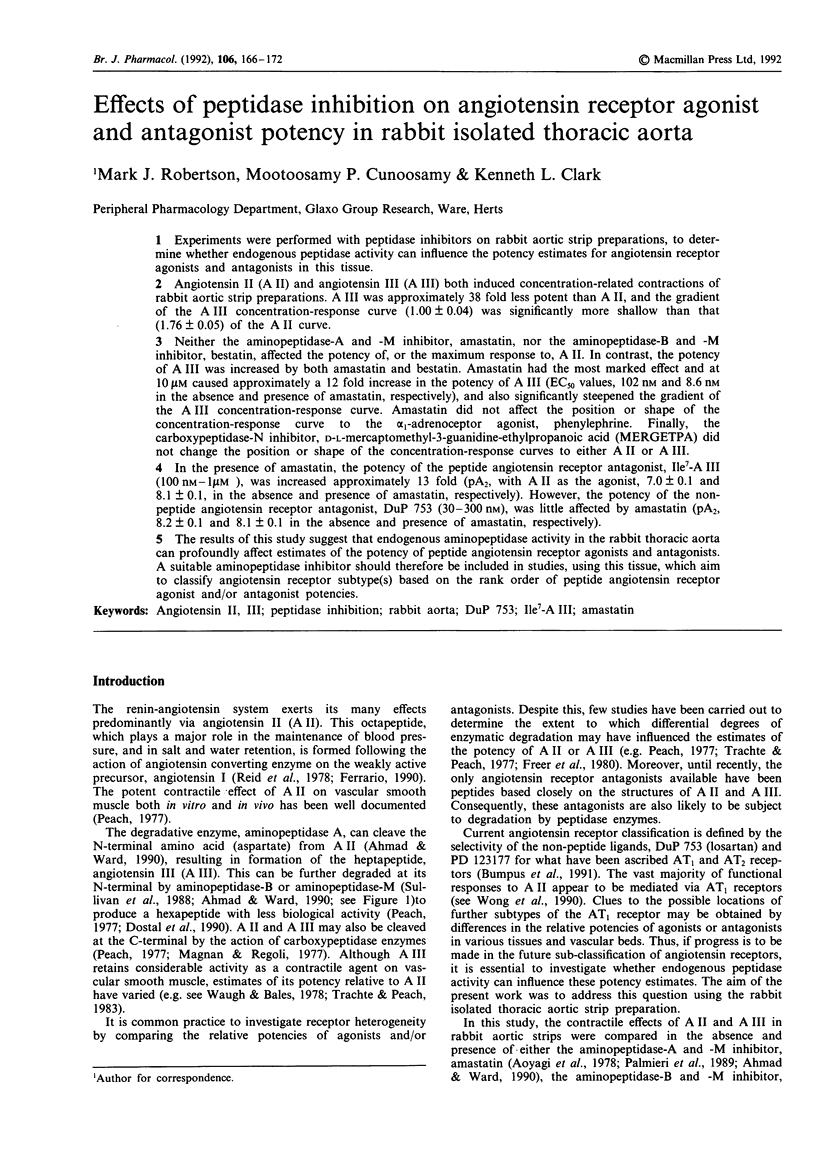
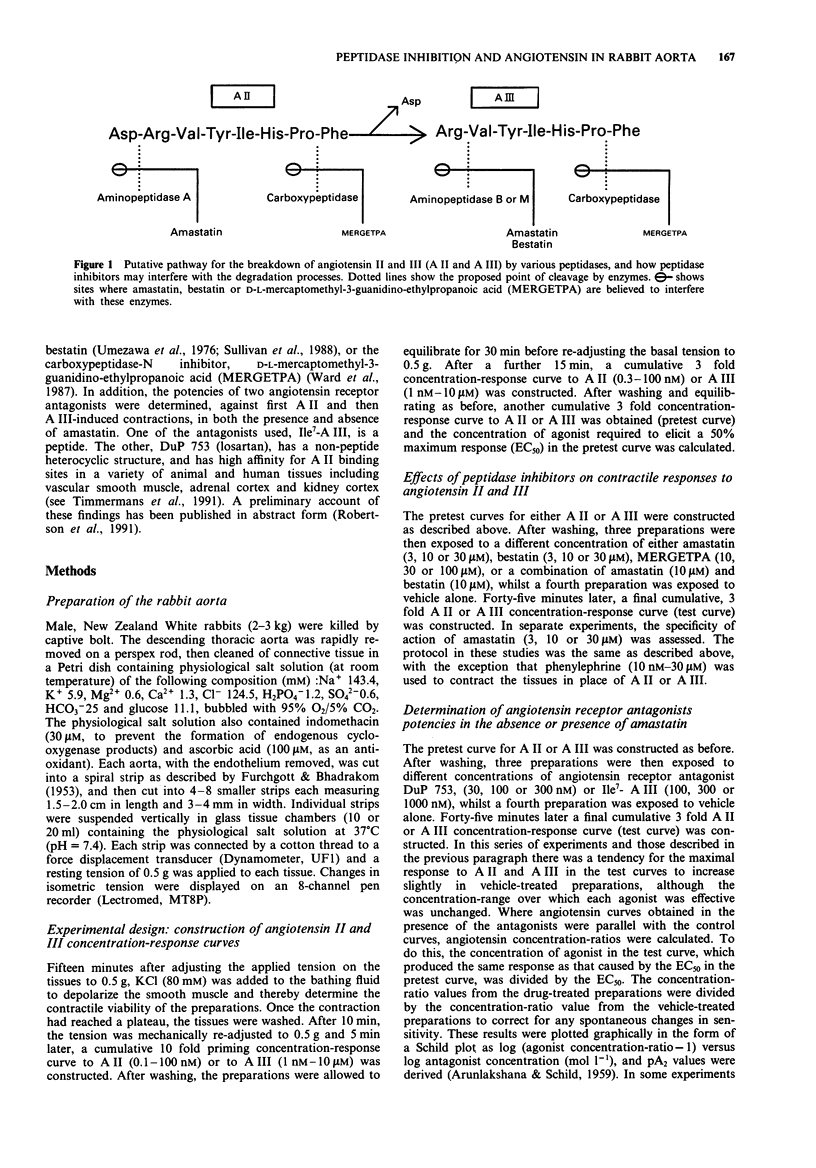

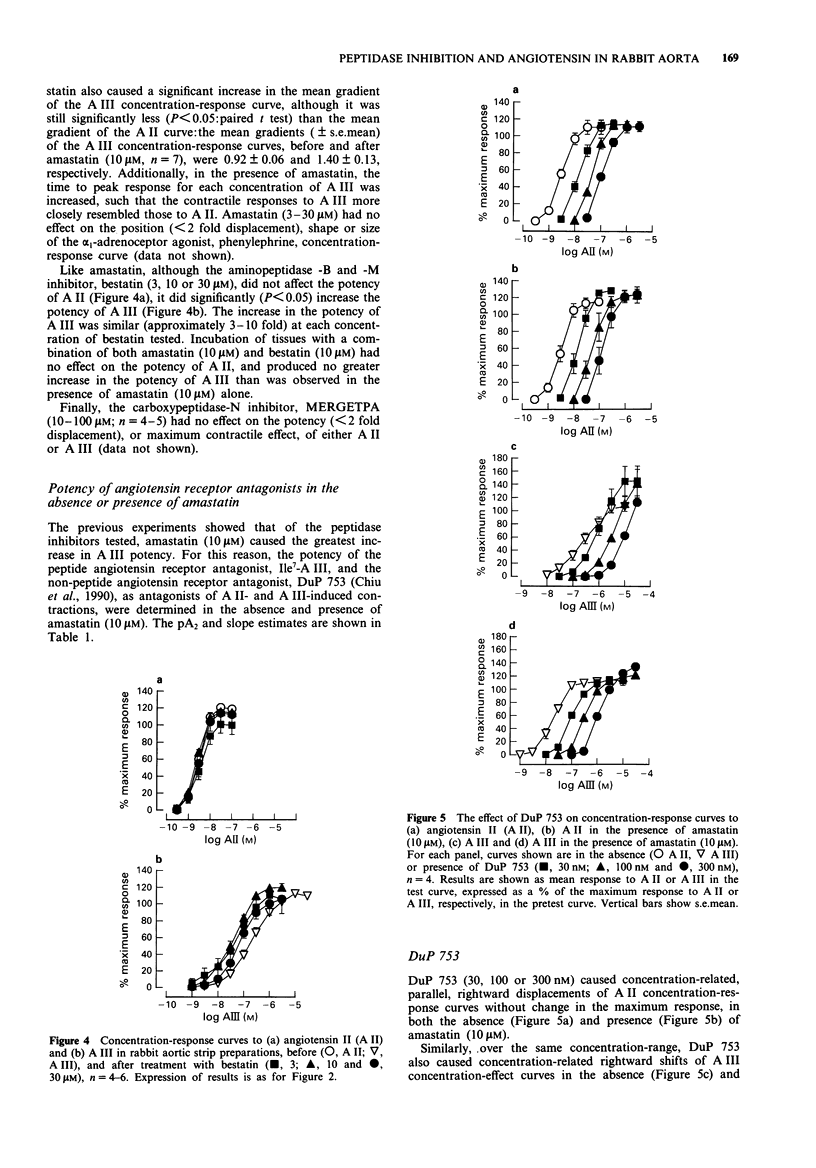
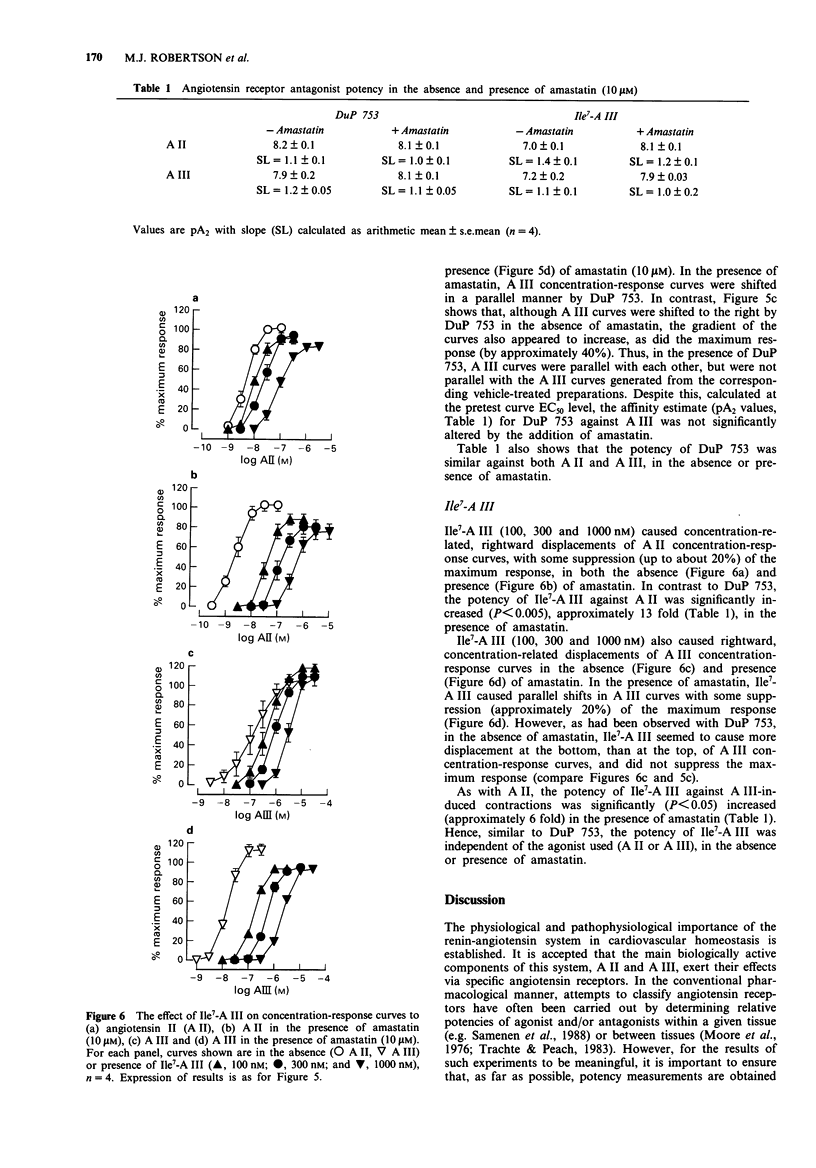
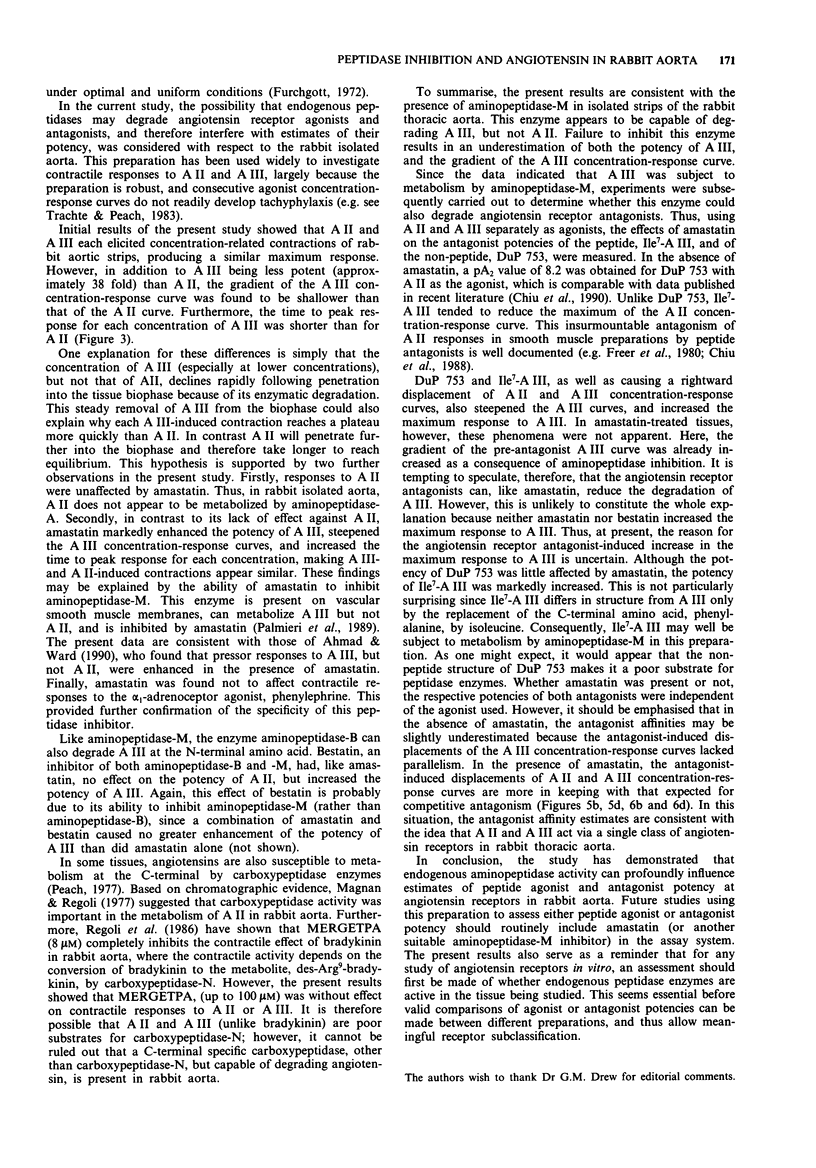
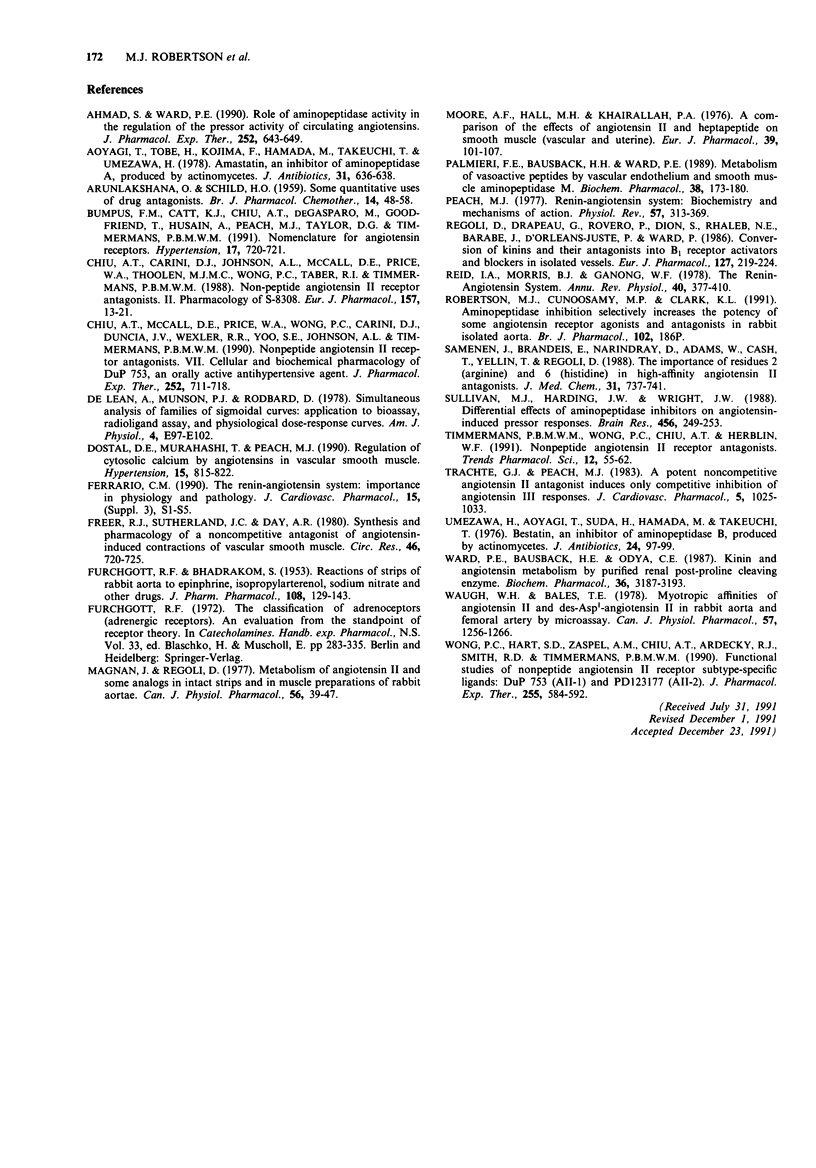
Selected References
These references are in PubMed. This may not be the complete list of references from this article.
- ARUNLAKSHANA O., SCHILD H. O. Some quantitative uses of drug antagonists. Br J Pharmacol Chemother. 1959 Mar;14(1):48–58. doi: 10.1111/j.1476-5381.1959.tb00928.x. [DOI] [PMC free article] [PubMed] [Google Scholar]
- Ahmad S., Ward P. E. Role of aminopeptidase activity in the regulation of the pressor activity of circulating angiotensins. J Pharmacol Exp Ther. 1990 Feb;252(2):643–650. [PubMed] [Google Scholar]
- Aoyagi T., Tobe H., Kojima F., Hamada M., Takeuchi T., Umezawa H. Amastatin, an inhibitor of aminopeptidase A, produced by actinomycetes. J Antibiot (Tokyo) 1978 Jun;31(6):636–638. doi: 10.7164/antibiotics.31.636. [DOI] [PubMed] [Google Scholar]
- Bumpus F. M., Catt K. J., Chiu A. T., DeGasparo M., Goodfriend T., Husain A., Peach M. J., Taylor D. G., Jr, Timmermans P. B. Nomenclature for angiotensin receptors. A report of the Nomenclature Committee of the Council for High Blood Pressure Research. Hypertension. 1991 May;17(5):720–721. doi: 10.1161/01.hyp.17.5.720. [DOI] [PubMed] [Google Scholar]
- Chiu A. T., Carini D. J., Johnson A. L., McCall D. E., Price W. A., Thoolen M. J., Wong P. C., Taber R. I., Timmermans P. B. Non-peptide angiotensin II receptor antagonists. II. Pharmacology of S-8308. Eur J Pharmacol. 1988 Nov 15;157(1):13–21. doi: 10.1016/0014-2999(88)90465-7. [DOI] [PubMed] [Google Scholar]
- Chiu A. T., McCall D. E., Price W. A., Wong P. C., Carini D. J., Duncia J. V., Wexler R. R., Yoo S. E., Johnson A. L., Timmermans P. B. Nonpeptide angiotensin II receptor antagonists. VII. Cellular and biochemical pharmacology of DuP 753, an orally active antihypertensive agent. J Pharmacol Exp Ther. 1990 Feb;252(2):711–718. [PubMed] [Google Scholar]
- DeLean A., Munson P. J., Rodbard D. Simultaneous analysis of families of sigmoidal curves: application to bioassay, radioligand assay, and physiological dose-response curves. Am J Physiol. 1978 Aug;235(2):E97–102. doi: 10.1152/ajpendo.1978.235.2.E97. [DOI] [PubMed] [Google Scholar]
- Dostal D. E., Murahashi T., Peach M. J. Regulation of cytosolic calcium by angiotensins in vascular smooth muscle. Hypertension. 1990 Jun;15(6 Pt 2):815–822. doi: 10.1161/01.hyp.15.6.815. [DOI] [PubMed] [Google Scholar]
- FURCHGOTT R. F., BHADRAKOM S. Reactions of strips of rabbit aorta to epinephrine, isopropylarterenol, sodium nitrite and other drugs. J Pharmacol Exp Ther. 1953 Jun;108(2):129–143. [PubMed] [Google Scholar]
- Freer R. J., Sutherland J. C., Jr, Day A. R. Synthesis and pharmacology of a noncompetitive antagonist of angiotensin-induced contractions of vascular smooth muscle. [Sarcosyl]1-[cysteinyl (s-methyl)]8-angiotensin II. Circ Res. 1980 May;46(5):720–725. doi: 10.1161/01.res.46.5.720. [DOI] [PubMed] [Google Scholar]
- Magnan J., Regoli D. Metabolism of angiotensin II and some analogs in intact strips and in muscle preparations of rabbit aortae. Can J Physiol Pharmacol. 1978 Feb;56(1):39–47. doi: 10.1139/y78-006. [DOI] [PubMed] [Google Scholar]
- Moore A. F., HAll M. M., Khairallah P. A. A comparison of the effects of angiotensin II and heptapeptide on smooth muscle (vascular and uterine). Eur J Pharmacol. 1976 Sep;39(1):101–107. doi: 10.1016/0014-2999(76)90117-5. [DOI] [PubMed] [Google Scholar]
- Palmieri F. E., Bausback H. H., Ward P. E. Metabolism of vasoactive peptides by vascular endothelium and smooth muscle aminopeptidase M. Biochem Pharmacol. 1989 Jan 1;38(1):173–180. doi: 10.1016/0006-2952(89)90165-2. [DOI] [PubMed] [Google Scholar]
- Peach M. J. Renin-angiotensin system: biochemistry and mechanisms of action. Physiol Rev. 1977 Apr;57(2):313–370. doi: 10.1152/physrev.1977.57.2.313. [DOI] [PubMed] [Google Scholar]
- Regoli D., Drapeau G., Rovero P., Dion S., Rhaleb N. E., Barabé J., D'Orléans-Juste P., Ward P. Conversion of kinins and their antagonists into B1 receptor activators and blockers in isolated vessels. Eur J Pharmacol. 1986 Aug 15;127(3):219–224. doi: 10.1016/0014-2999(86)90367-5. [DOI] [PubMed] [Google Scholar]
- Reid I. A., Morris B. J., Ganong W. F. The renin-angiotensin system. Annu Rev Physiol. 1978;40:377–410. doi: 10.1146/annurev.ph.40.030178.002113. [DOI] [PubMed] [Google Scholar]
- Samanen J., Brandeis E., Narindray D., Adams W., Cash T., Yellin T., Regoli D. The importance of residues 2 (arginine) and 6 (histidine) in high-affinity angiotensin II antagonists. J Med Chem. 1988 Apr;31(4):737–741. doi: 10.1021/jm00399a008. [DOI] [PubMed] [Google Scholar]
- Sullivan M. J., Harding J. W., Wright J. W. Differential effects of aminopeptidase inhibitors on angiotensin-induced pressor responses. Brain Res. 1988 Jul 26;456(2):249–253. doi: 10.1016/0006-8993(88)90224-7. [DOI] [PubMed] [Google Scholar]
- Timmermans P. B., Wong P. C., Chiu A. T., Herblin W. F. Nonpeptide angiotensin II receptor antagonists. Trends Pharmacol Sci. 1991 Feb;12(2):55–62. doi: 10.1016/0165-6147(91)90498-h. [DOI] [PubMed] [Google Scholar]
- Todorov L., Windisch K., Shersen H., Lajtha A., Papasova M., Vizi E. S. Prejunctional nicotinic receptors involved in facilitation of stimulation-evoked noradrenaline release from the vas deferens of the guinea-pig. Br J Pharmacol. 1991 Jan;102(1):186–190. doi: 10.1111/j.1476-5381.1991.tb12151.x. [DOI] [PMC free article] [PubMed] [Google Scholar]
- Trachte G. J., Peach M. J. A potent noncompetitive angiotensin II antagonist induces only competitive inhibition of angiotensin III responses. J Cardiovasc Pharmacol. 1983 Nov-Dec;5(6):1025–1033. doi: 10.1097/00005344-198311000-00017. [DOI] [PubMed] [Google Scholar]
- Umezawa H., Aoyagi T., Suda H., Hamada M., Takeuchi T. Bestatin, an inhibitor of aminopeptidase B, produced by actinomycetes. J Antibiot (Tokyo) 1976 Jan;29(1):97–99. doi: 10.7164/antibiotics.29.97. [DOI] [PubMed] [Google Scholar]
- Ward P. E., Bausback H. H., Odya C. E. Kinin and angiotensin metabolism by purified renal post-proline cleaving enzyme. Biochem Pharmacol. 1987 Oct 1;36(19):3187–3193. doi: 10.1016/0006-2952(87)90631-9. [DOI] [PubMed] [Google Scholar]
- Waugh W. H., Bales T. E. Myotropic affinities of angiotensin II and des-AspI-angiotensin II in rabbit aorta and femoral artery by microassay. Can J Physiol Pharmacol. 1979 Nov;57(11):1256–1266. doi: 10.1139/y79-190. [DOI] [PubMed] [Google Scholar]
- Wong P. C., Hart S. D., Zaspel A. M., Chiu A. T., Ardecky R. J., Smith R. D., Timmermans P. B. Functional studies of nonpeptide angiotensin II receptor subtype-specific ligands: DuP 753 (AII-1) and PD123177 (AII-2). J Pharmacol Exp Ther. 1990 Nov;255(2):584–592. [PubMed] [Google Scholar]


